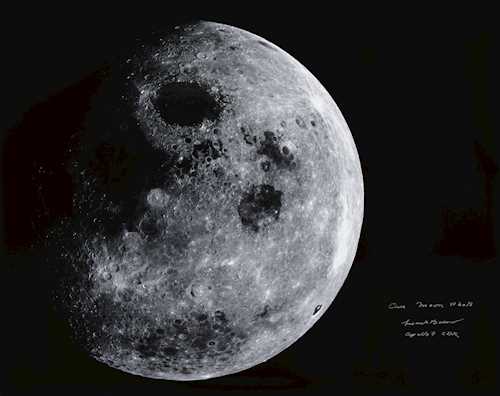
Lot 4019* - A211 Out of This World - Dienstag, 03. Dezember 2024, 17.00 Uhr
LOT OF TWO PHOTOGRAPHS
APOLLO 8 ‘OUR MOON’, SIGNED BY FRANK BORMAN
21–27 December 1968
Silk finish photography
51 × 40 cm
21–27 December 1968
Silk finish photography
51 × 40 cm
Certificate: Letter of authenticity from Steve Zarelli
Apollo 8 marked the extraordinary moment in history when humans truly left their home planet for the first time. William Anders, James Lovell and Frank Borman became the first human beings to see the earth as a sphere hanging in space; a great milestone for human consciousness.
The photo presented here shows the nearly full moon, taken from the Apollo 8 spacecraft at a point above 70 degrees east longitude. It is signed by Frank Borman.
‘SATURN’ TAKEN BY THE VOYAGER 2 SPACE PROBE
1981
Kodak photo
20 × 25.5 cm
Voyager 2 is a NASA space probe made to explore the outer planetary system as part of the Voyager programme. It was launched on 20 August 1977. Its identically constructed twin, Voyager 1, was launched 16 days later on a different trajectory.
Its encounter with Saturn began on 22 August 1981, two years after leaving the Jovian system, with imaging of the moon Iapetus. Voyager 2 is the only spacecraft to visit Uranus and Neptune, and is now in interstellar space.
This mission is considered one of the greatest successes of NASA and space travel in general, as the probe has far exceeded its planned life expectancy and still regularly sends data to Earth today.
Apollo 8 marked the extraordinary moment in history when humans truly left their home planet for the first time. William Anders, James Lovell and Frank Borman became the first human beings to see the earth as a sphere hanging in space; a great milestone for human consciousness.
The photo presented here shows the nearly full moon, taken from the Apollo 8 spacecraft at a point above 70 degrees east longitude. It is signed by Frank Borman.
‘SATURN’ TAKEN BY THE VOYAGER 2 SPACE PROBE
1981
Kodak photo
20 × 25.5 cm
Voyager 2 is a NASA space probe made to explore the outer planetary system as part of the Voyager programme. It was launched on 20 August 1977. Its identically constructed twin, Voyager 1, was launched 16 days later on a different trajectory.
Its encounter with Saturn began on 22 August 1981, two years after leaving the Jovian system, with imaging of the moon Iapetus. Voyager 2 is the only spacecraft to visit Uranus and Neptune, and is now in interstellar space.
This mission is considered one of the greatest successes of NASA and space travel in general, as the probe has far exceeded its planned life expectancy and still regularly sends data to Earth today.
CHF 1 000 / 2 000 | (€ 1 030 / 2 060)


